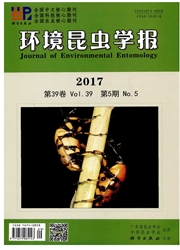

 中文摘要:
中文摘要:
沙葱萤叶甲为近年来在内蒙古草原猖獗成灾的新害虫,为明确温度对其发育速率的影响,分别设置5个变温组合(8/20℃,11/23℃,14/26℃,17/29℃和20/32℃)和6个恒温(13℃,17℃,21℃,25℃,29℃和33℃),比较了变温和恒温对沙葱萤叶甲幼虫和蛹发育速率的影响。结果表明,不同变温组合和恒温对沙葱萤叶甲幼虫和蛹的发育速率有显著的影响。发育历期随温度的升高而缩短,在变温条件下,1龄幼虫期、2龄幼虫期、3龄幼虫期、总幼虫期和蛹期分别从最低温度组合(8/20℃,平均15℃)的11.00,13.44,23.18,46.42和16.89 d,缩短至最高温度组合(20/32℃,平均27℃)的4.92,4.63,9.17,17.83和5.83 d;在恒温条件下,13℃下幼虫不能发育和存活,1龄幼虫期、2龄幼虫期、3龄幼虫期、总幼虫期和蛹期分别从17℃的14.50,10.75,20.63,45.50和11.00 d,缩短至33℃的6.10,5.47,10.60,22.17和5.33 d。在变温条件下,幼虫和蛹的发育起点温度分别为7.44℃和8.48℃,有效积温分别为344.82日度和113.52日度;在恒温条件下,幼虫和蛹的发育起点温度分别为0.64℃和5.11℃,有效积温分别为714.28日度和147.06日度。变温促进了沙葱萤叶甲幼虫和蛹的发育,本研究结果为沙葱萤叶甲的预测预报及综合防控提供了科学依据。
 英文摘要:
英文摘要:
Galeruca daurica(Joannis) is a new pest causing great damages in Inner Mongolia grasslands in recent years. This study aims to understand the effects of alternating and constant temperatures on the individual developmental rate. We compared the influence of five combinations of alternating temperatures(8/20℃,11/23℃,14/26℃,17/29℃ and 20/32℃) and six constant temperatures(13℃,17℃,21℃,25℃,29℃ and 33℃) on the developmental rates of G. daurica larvae and pupae. The results showed that both alternating and constant temperatures affected significantly the developmental rates of G.daurica larvae and pupae. The developmental durations of various instar larvae and pupae shortened as the temperature increased. The developmental durations of 1stinstar,2ndinstar,3rdinstar,larvae and pupae shortened from 11. 00,13. 44,23. 18,46. 42 and 16. 89 d at the lowest combination of alternating temperature(8/20℃, average at 15℃) to 4. 92,4. 63,9. 17,17. 83 and 5. 83 d at the highest combination(20/32℃,average at 27℃),respectively. The larvae could not develop and died in the 1stinstar at constant temperature of 13℃. The developmental durations of 1stinstar,2ndinstar,3rdinstar,larvae and pupae shortened from 14. 50,10. 75,20. 63,45. 50 and 11. 00 d at constant temperature of17℃ to 6. 10,5. 47,10. 60,22. 17 and 5. 33 d at 33℃,respectively. At the alternating temperatures,the developmental threshold temperatures of larvae and pupae were 7. 44℃ and 8. 48℃,respectively,and the effective accumulated temperatures were 344. 82 and 113. 52 degree-days,respectively. At the constant temperatures,the developmental threshold temperatures of larvae and pupae were 0. 64℃ and 5. 11℃,respectively, and the effective accumulated temperatures were 714. 28 and 147. 06 degree-days,respectively. The alternating temperature can promote the development of G. daurica larvae and pupae.These results provide a scientific basis for the forecasting and integrated management of this pest.
 同期刊论文项目
同期刊论文项目
 同项目期刊论文
同项目期刊论文
 期刊信息
期刊信息
